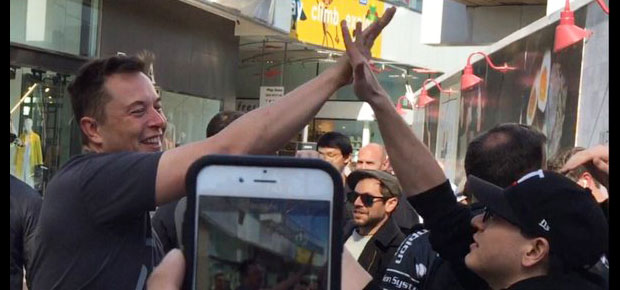Tesla fans around the world queued up to add their names to a reservation list in anticipation of Tesla Motors’ planned Thursday night unveiling of its Model 3. The long-awaited new addition to the Tesla line is a more affordable sedan that targets not just early adopters, but a larger audience of luxury car owners.
Company founder Elon Musk has shared key details in advance of the reveal. The Model 3 will offer a 200-mile range and will come with a US$35,000 sticker price — which could drop to around $27,500 after tax credits.
The Model 3 is expected to arrive by late 2017.
Electrifying the Masses
The Model 3 is poised to be a game changer for the company, which has developed a cult following but so far has failed to break out to the masses. Tesla reportedly sold just 42,000 vehicles in the United States in 2014 and 2015, and while it has announced plans to sell some 90,000 Model S and Model X cars this year, it is still far from going mainstream.
The Model 3 could change that, according to Rob Enderle, principal analyst at the Enderle Group.
“This is Tesla’s first affordable car falling into a segment and size far more attractive to a far wider range of buyers,” he told TechNewsWorld.
“This takes them far closer to a mainstream auto company,” Enderle said.
“So the hope is this breaks them out,” he added. “The risk is that this far higher volume will overwhelm the existing stressed charging ecosystem, particularly the critical — for Tesla drivers — superchargers.”
Taxing Issues
Tax credits are meant to entice early adopters, but they aren’t open ended. Nor is Tesla alone in utilizing the federal tax credits to help attract buyers to electric vehicles. Moreover, the tax credits are available only for the first 200,000 vehicles from a manufacturer and are phased out as sales increase. Thus, Tesla’s potential success could impact those credits and the savings for its buyers.
“There is still space in the market, but this vehicle has the potential to be higher volume in sales,” said Stephanie Brinley, senior analyst at IHS Automotive.
“It is an important point but could be a ways before we see the credits go away,” she told TechNewsWorld.
More importantly, the $30,000 price point would apply only to the most basic models, so many would-be buyers should expect to pay more for added features.
“As with any luxury automobile, there can be a price ladder that means a $15,000 to $18,000 increase from base to top,” Brinley added. “As a result, the entry level may not be the largest-selling vehicle anyway.”
High Expectations
Despite the fact that the costs for the Tesla Model 3 could exceed the budgets of many consumers, there is still the potential for considerable interest.
“Tesla has become the Apple of the motorcar industry; just as people trust Apple with the latest thing, Tesla is filling that space when it comes to cars,” said Peter Harrop, chairman ofIDTechEx.
“For the masses, it has been that only rich people could buy one, but now the Tesla is becoming something closer to what they can afford,” he told TechNewsWorld.
“There is still excitement because this is about a Tesla that is more affordable than the other models,” noted IHS Automotive’s Brinley. “However, it may be difficult to maintain the hype after the initial orders have been placed, and that pace may be hard to maintain.”
Beyond the Luxury
For Tesla to succeed, it has to widen its potential audience, especially as it seeks to reach profitability, she added. The Model 3 could set the automaker on the right path, but it could still be a long road ahead.
“It would be less critical if it wasn’t aimed at the mainstream, but right now Tesla is at a point where it has to reach profitability sooner than later,” Brinley said.
“One of the important things is for Tesla to generate buzz and cash flow, but to succeed they have to bring in non-luxury buyers — especially in 2019 and 2020 when the hype from the Model 3 dies down,” she noted.
That presents another challenge for the automaker.
“This means coming from upmarket to downmarket, and that doesn’t immediately work because they don’t have the economy of scale to do something for the everyman,” said Harrop.
“It will be interesting to see if Elon Musk can manage to do this, which is a major leap for any luxury brand,” he added. “In industrial terms, companies normally upmarket from a downmarket, and for Tesla it means going from luxury to masses — and that will be tricky to pull off.”






















































